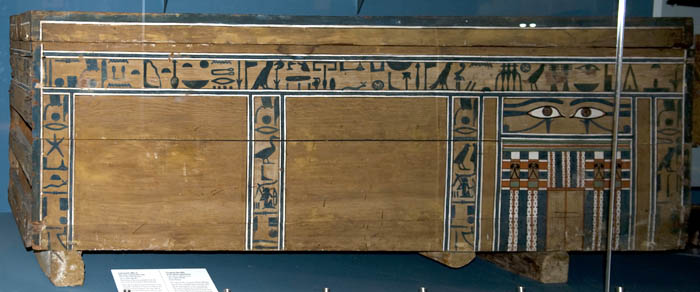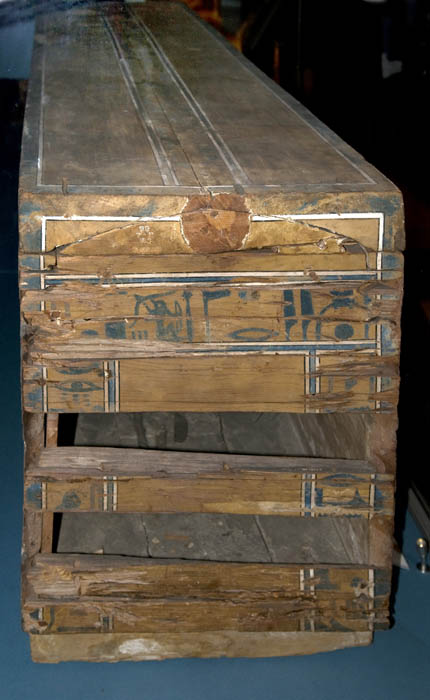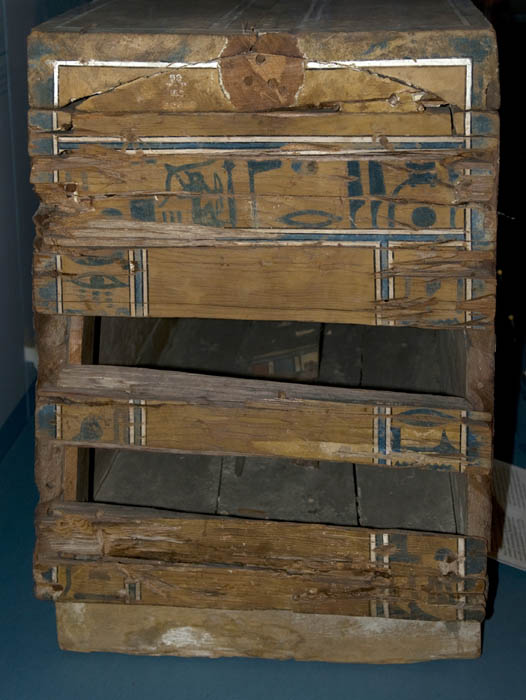
Cedarwood coffin of the army commander Sepi from Deir el-Bersha and dating to the mid to late 12th Dynasty. The coffin was within forecourt of the tomb of Governor Djehutyhotep (EA 55315). This coffin has an undecorated interior, however Coffins of this period (1st Intermediate to Middle Kingdom) often had their interiors decorated with scenes of heaped offering tables including clothing, jewellery, tools, weapons, etc. to ensure the deceased well-being in the eternity. Extracts from the Coffin-Texts were inscribed and these magical spells would assist in passing onto the next world. The exterior was primarily decorated with scenes related to the funerary rituals to resurrect the dead through association with the creator gods - primarily Osiris and Ra.
The coffin is aligned to the points-of-the-compass, with the east side (the long side visible in the above picture, being the east). The top end is North, the far-side is west and the foot (see two final pictures) is the south. The body was laid on its left-side so that his eyes could look out of the east-side through the two painted Wadjet eyes and share the daily rebirth via the newly rejuvenated sun at sunrise. The inscriptions run from the head at the northern end towards the feet at the southern end. On the long eastern side the inscriptions are mainly an offering formula to Osiris; the western side is an offering formula to Anubis. The corners of the coffin have inscriptions to the four sons of Horus who are protective deities for the Sepi's body; Imseti and Duamutef are on the eastern corners and Hapy and Qebehsenuef on the western corners. The central columns invoke other deities who were closely linked to Osiris - on the eastern-side Shu (towards the northern end) and Geb (toward the southern end) on the western-side are Tefnet (towards the northern end) and Nut (towards the southern end).
| Top: |
| Htp di nsw Asir nb Ddw xnty-imntw nTr aA nb AbDw di=f prt-xrw t ka Apd xA sntr xt nbt nfrt wabt n kA n imAx(y) spi mAa-xrw |
| An offering which the King gives to Osiris the Lord of Djedu (Bubastis) and to Khentyimentu so that he may give a voice-offering of bread, foul, ox, incense, and a thousand of everything good and pure for the Ka of the revered Sepi, the justified (true of voice) |
| Left: |
| imAx(y) xr dwA-mwt=f spi mAa-xrw |
| Sepi true of voice, the revered one before Duamutef |
| Left centre: |
| imAx(y) xr gb mSa spi mAa-xrw |
| General Sepi true of voice, the revered one before Geb |
| Right Centre: |
| imAx(y) xr Sw mSa spi mAa-xrw |
| General Sepi true of voice, the revered one before Shu |
| Right: |
| imAx(y) xr imsti spi mAa-xrw |
| Sepi true of voice, the revered one before Imseti |
| Wadjet Eyes: |
| ptr nfrw |
| Viewing the splendour |
|
The decorated tombs in the cliffs of Deir el-Bersha date from the Old Kingdom, First Intermediate Period and Middle Kingdom, when it was the principal cemetery of Hermopolis. Early excavations at the site brought to light a number of high-status burials, some of them substantially intact. The most famous and most impressive of the Middle Kingdom tombs was constructed for Djehutihotep, a governor who ruled during the 12th Dynasty reigns of Amenemhet II, Senusret II, and Senusret III. Djehutihotep’s was 'Great Overlord of the Hare Province' and his tomb has a portico with two palm-columns, a rectangular inner hall and a deep cult chamber with a statue niche up a short flight of steps. The tomb is known for a unique painted scene depicting the transportation of a colossal statue of the deceased from the alabaster quarries at Hatnub to his mortuary chapel. The scene shows how the 60 tonnes 6.5m statue was dragged on a wooden sledge by 172 men pulling with ropes, while another man pours something (presumably water) from a jar to lubricate the ground in front of the sledge.


